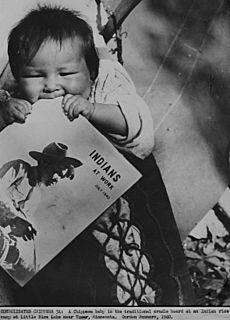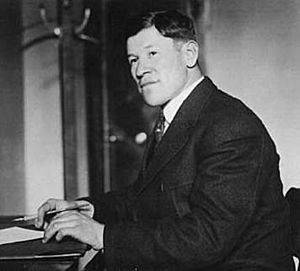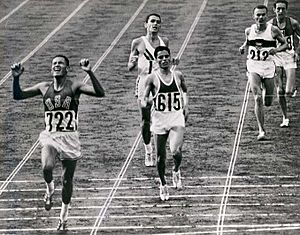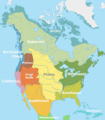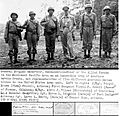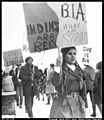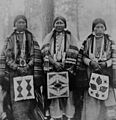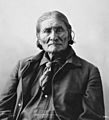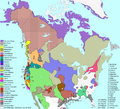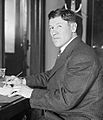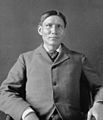Native Americans in the United States facts for kids
       
Native Americans of the United States (from top left):
Joseph Brant · Sequoyah · Pushmataha · Tecumseh Touch the Clouds · Chief Joseph · Charles Eastman Holmes Colbert · Jim Thorpe · John Herrington |
|
| Total population | |
|---|---|
| American Indian and Alaska Native One race: 2.5 million are registered In combination with one or more other races: 1.6 million are registered 1.37% of the US population |
|
| Regions with significant populations | |
(predominantly the West and South) |
|
| Languages | |
| English language French language Spanish language Native American languages |
|
| Religion | |
| Protestant Sacred Pipe Kiva Religion Long House Roman Catholic Russian Orthodox |
|
| Related ethnic groups | |
| Indigenous peoples of the Americas |
Native Americans in the United States are the first people who lived in the areas now part of the United States. This includes parts of Alaska.
The Cherokee tribe was one of the first Native American groups to become US citizens. In the 1800s, settlers called the Cherokee one of the "Five Civilized Tribes." The other tribes were the Chicksaw, Choctaw, Creek, and Seminole.
Today, there are about 310 Indian reservations in the US. However, most Native Americans do not live on a reservation anymore.
Contents
- History of Native Americans in the US
- Native American Society, Language, and Culture
- Many Different Native American Languages
- Native American Cultural Aspects
- How Native American Tribes Were Organized
- Native American Society and Art
- Native American Agriculture and Food
- Native American Religion and Beliefs
- Native American Gender Roles
- Native American Sports and Games
- Native American Music and Art
- Native American Economy and Trade
- Images for kids
- See also
History of Native Americans in the US
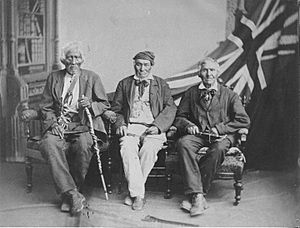
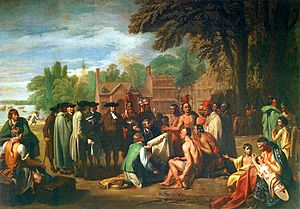
When Europeans came to the Americas, it led to many years of disagreements. Native Americans had different ways of life than the Europeans. These differences caused many misunderstandings and long-lasting problems.
Before Christopher Columbus arrived, millions of Native Americans lived in what is now the United States. Estimates range from 1 million to 18 million people.
After the American colonies became the United States, a belief called "Manifest Destiny" grew. This idea suggested that Americans were meant to expand across the continent. In the late 1700s, leaders like George Washington wanted to "civilize" Native Americans. They hoped Native Americans would become US citizens.
This idea of assimilation (meaning to become like the main culture) continued for many years. Sometimes, Native Americans chose to assimilate, like the Choctaw. Other times, they were forced to. In the early 1800s, many Native Americans were moved from their homes in the South. This made room for American expansion.
By the time of the American Civil War, many Native American nations had been moved west of the Mississippi River. There were many "Indian Wars" where Native Americans fought back. These conflicts happened often until the 1890s.
Native American Society, Language, and Culture
Many Different Native American Languages
Native Americans were not one single group. They were divided into hundreds of different groups, each with its own language and culture. These languages belong to many large families, like Na-Dené, Algic, and Uto-Aztecan. It has been hard to show how these languages are related because there is so much variety.
The native peoples of North America can be grouped into several large cultural areas:
- Alaska Natives
- Arctic: People like the Eskimo-Aleut.
- Subarctic: People who speak Northern Athabaskan languages.
- Western United States
- Californian tribes: Many different language groups.
- Plateau tribes: People who speak Interior Salish languages.
- Great Basin tribes: People who speak Uto-Aztecan languages.
- Pacific Northwest Coast: People who speak Pacific Coast Athabaskan languages.
- Southwestern tribes: People who speak Uto-Aztecan and Southern Athabaskan languages.
- Central United States
- Plains Indians: People who speak Siouan and Plains Algonquian languages.
- Eastern United States
- Northeastern Woodlands tribes: People who speak Iroquoian and Algonquian languages.
- Southeastern tribes: People who speak Muskogean and Siouan languages.
Today, Uto-Aztecan languages have the most speakers, especially because of the Nahuatl language in Mexico. Nadene languages are second, with about 180,200 speakers. Most of these are speakers of Navajo.
Native American Cultural Aspects
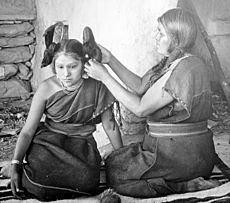
Native American tribes had many different cultures, languages, clothes, and customs. However, some things were common among many tribes.
Early hunter-gatherer tribes made weapons from stone. Later, they used new technologies. Before Europeans arrived, most tribes used similar weapons. The most common were the bow and arrow, war club, and spear. Their quality and design varied. Native Americans also used fire to help them find food and change the land. This helped their communities grow.
Large animals like mammoths disappeared around 8,000 B.C. Native Americans then hunted other big animals, like bison. The Great Plains tribes were still hunting bison when they met Europeans. In the 1600s, Native Americans got horses from the Spanish. Learning to ride horses greatly changed their culture. It changed how they hunted large animals. Horses also became very important in Native life and showed how wealthy someone was.
How Native American Tribes Were Organized

Early European scholars said that Native American societies were often based on clans or gentes before tribes formed. Clans are groups of families who share a common ancestor. Some common features of these groups were:
- They could choose and remove their leaders.
- They had rules about who could marry whom.
- They helped and defended each other.
- They had shared burial places.
- They had councils to make decisions.
Tribes developed from these smaller groups. North America had over forty different language families. Each independent tribe spoke a dialect of one of these languages. Some things that tribes had were:
- They had their own clans.
- They could remove leaders.
- They had their own religious beliefs and ceremonies.
- They had a government run by a council of chiefs.
- Sometimes, they had a main chief for the whole tribe.
Native American Society and Art
The Iroquois people, who lived around the Great Lakes, used special strings or belts called wampum. These belts had knots and beaded designs. They helped people remember tribal stories and legends. Wampum also served as a way to trade and measure value. The people who kept the wampum were important tribal leaders.
Pueblo peoples made amazing items for their religious ceremonies. Kachina dancers wore colorful masks. They used these masks to act out different ancestral spirits. While large sculptures were not common, they made carved stone and wood figures for religious use. Their textile art was excellent, with beautiful weaving and rich colors. They also made jewelry from turquoise and shells, and high-quality pottery.
Navajo spirituality focused on living in harmony with the spirit world. They often did ceremonies that included sandpainting. These paintings used colored sand, charcoal, cornmeal, and pollen to show specific spirits. These bright and detailed sand creations were erased at the end of the ceremony.
Native American Agriculture and Food
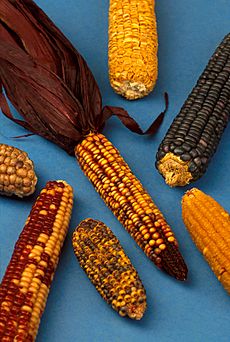
Native American agriculture began about 7,000 years ago in what is now Illinois. The first crop they grew was squash. This was one of many plants Native Americans learned to grow. Other crops included cotton, sunflower, pumpkins, tobacco, and goosefoot.
Farming in the Southwest started about 4,000 years ago. Traders brought new plants from Mexico. The climate in the Southwest was very different, from cool mountains to dry deserts. So, Native Americans had to be clever to farm successfully. They used irrigation to bring water to dry areas. They also chose seeds from the best plants to grow stronger crops. In the Southwest, they grew beans that supported themselves, much like today.
In the East, however, beans were planted next to corn. The bean vines would climb the cornstalks. The most important crop for Native Americans was maize (corn). It first started in Mesoamerica and then spread north. About 2,000 years ago, it reached eastern America. Corn was vital because it was a daily food. It could be stored in underground pits for winter. Also, no part of the corn was wasted. The husk was used for crafts, and the cob was used for fuel. By 800 A.D., Native Americans had three main crops: beans, squash, and corn. These were called the "Three Sisters."
The farming roles for men and women varied by region. In the Southwest, men prepared the soil with hoes. Women were in charge of planting, weeding, and harvesting. In most other regions, women did all the farming tasks, including clearing the land. Clearing land was a huge job because Native Americans often moved their fields.
There is a story that Squanto showed the Pilgrims how to use fish as fertilizer. However, whether this story is true is debated. Native Americans did plant beans next to corn. The beans would put nitrogen back into the soil, which corn takes out. They also used corn stalks for support. Indians used controlled fires to burn weeds and clear fields. This put nutrients back into the ground. If this did not work, they would leave the field to rest and find a new spot.
Europeans in the East saw that Native Americans cleared large areas for farming. Their fields in New England sometimes covered hundreds of acres. Colonists in Virginia noted thousands of acres farmed by Native Americans.
Native Americans commonly used tools like the hoe, maul, and dibber. The hoe was the main tool for tilling the land and weeding. Early hoes were made of wood and stone. When settlers brought iron, Native Americans switched to iron hoes and hatchets. The dibber was a digging stick used to plant seeds. After harvesting, women prepared the food. They used the maul to grind corn into mash. This was cooked or baked as corn bread.
Native American Religion and Beliefs

The Midewiwin Lodge is a traditional medicine society. It is based on the stories and prophecies of the Ojibwa and related tribes. Traditional practices include burning sacred herbs like tobacco and sweetgrass. Other practices are the sweatlodge, fasting (important for "vision quests"), singing, and drumming. Smoking natural tobacco in a pipe is also common. A person practicing Native American spiritualities might use some or all of these in their rituals.
Another important religious group among Native peoples is the Native American Church. This church combines parts of native spiritual practices from many tribes. It also includes symbols from Christianity.
Native Americans are the only group in the United States who need a federal permit to practice their religion. The eagle feather law says that only people with proven Native American ancestry, who are part of a federally recognized tribe, can legally get eagle feathers. These feathers are used for religious or spiritual purposes. Many Native Americans and non-Native Americans argue about this law. They say it is unfair and limits tribal rights. The law also does not allow Native Americans to give eagle feathers to non-Native Americans. This is a common practice, both now and in the past. Many non-Native Americans have been adopted into Native American families and given eagle feathers.
Native American Gender Roles
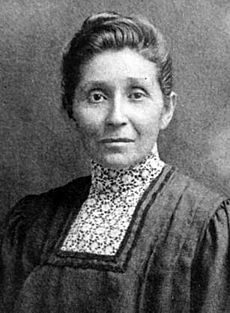
Most Native American tribes had traditional roles for men and women. In some tribes, like the Iroquois, family and clan relationships were matrilineal. This means that family lines were traced through the mother. Women often had a lot of power and owned family property, like with the Cherokee.
Men usually hunted, traded, and went to war. Women gathered plants, cared for children and elders, made clothes and tools, and prepared meat. Mothers used a cradleboard to carry their babies while working or traveling. In some tribes, a kind of transgender person called a Two-Spirit was accepted.
Besides taking care of the home, women had many important tasks for the tribe's survival. They made weapons and tools. They also took care of the roofs of their homes. Often, they helped men hunt bison. In some Plains Indian tribes, there were reportedly medicine women. They gathered herbs and healed the sick.
In some tribes, like the Sioux, girls were encouraged to learn to ride, hunt, and fight. While fighting was mostly for boys and men, women sometimes fought alongside them. This was especially true when the tribe's existence was in danger.
Native American Sports and Games
Native Americans enjoyed competitive individual and team sports during their free time. Early stories describe team games between tribes with hundreds of players. Famous Native American athletes include Jim Thorpe, Notah Begay III, Jacoby Ellsbury, and Billy Mills.
Team Sports
Native American ball sports are sometimes called lacrosse, stickball, or baggataway. These games were often used to settle arguments between tribes instead of going to war. This was a peaceful way to solve problems. The Choctaw called it ISITOBOLI ("Little Brother of War"). The Onondaga name was DEHUNTSHIGWA'ES ("men hit a rounded object").
There are three main types of the game: Great Lakes, Iroquoian, and Southern. The game is played with one or two rackets or sticks and one ball. The goal is to get the ball into the opposing team's goal. This could be a single post or a net. Players also try to stop the other team from scoring. The game can have as few as twenty players or as many as 300. There are no height or weight limits, and no protective gear is worn. The goals could be a few hundred feet apart or a few miles. In modern Lacrosse, the field is 110 yards. A Jesuit priest wrote about stickball in 1729, and George Catlin painted scenes of the game.
Individual Sports
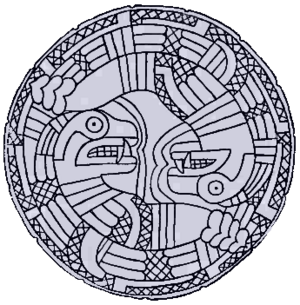
Chunke was a game played with a stone disk. The disk was about 1–2 inches long and shaped like a circle. It was rolled down a 200-foot corridor very fast. Players would throw wooden sticks at the moving disk. The goal was to hit the disk or stop your opponents from hitting it.
Native American Music and Art
Traditional Native American music is mostly sung with one main melody. However, there are some exceptions. Native American music often includes drumming and playing rattles or other percussion instruments. Other instruments are not as common. Flutes and whistles made of wood, cane, or bone are also played. Usually, individuals play them. But in the past, large groups sometimes played them together. The tuning of these flutes is not exact. It depends on the wood's length and the player's hand size.
Some performers with Native American parents have become famous in American popular music. These include Robbie Robertson, Rita Coolidge, and Buffy Sainte-Marie. Some artists, like John Trudell, use music to talk about life in Native America. Others, like R. Carlos Nakai, mix traditional sounds with modern music. Many small and medium-sized music companies offer new music by Native American artists. This music ranges from pow-wow drum music to rock-and-roll and rap.
The most common public music form among Native Americans in the United States is the pow-wow. At pow-wows, like the yearly Gathering of Nations in Albuquerque, New Mexico, drum groups sit in a circle around a large drum. They play together while singing in a native language. Dancers in colorful outfits dance clockwise around the drum groups. Common pow-wow songs include honor songs, intertribal songs, and welcome songs. Most native communities also have traditional songs and ceremonies. Some of these are only shared and practiced within their own community.
Native American art is a major part of world art. Native American contributions include pottery, paintings, jewellery, weavings, sculptures, basketry, and carvings. Franklin Gritts was a Cherokee artist. He taught students from many tribes at Haskell Institute (now Haskell Indian Nations University) in the 1940s. This time was called the "Golden Age" of Native American painters.
There is a law that protects the honesty of certain Native American artworks. This law stops art from being sold as Native American if it was not made by a registered Native American artist.
Native American Economy and Trade
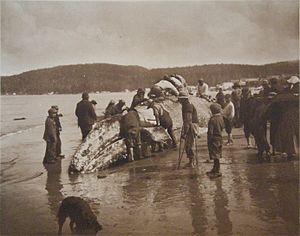
The Inuit, also called Eskimo, prepared and stored large amounts of dried meat and fish. Pacific Northwest tribes made long canoes, 40–50 feet, for fishing. Farmers in the Eastern Woodlands grew fields of corn using hoes and digging sticks. Their neighbors in the Southeast grew tobacco and food crops. On the Plains, some tribes farmed. They also planned buffalo hunts where herds were driven over cliffs. People living in the Southwest deserts hunted small animals. They gathered acorns to grind into flour, which they used to bake thin bread on hot stones. Some groups in the region developed ways to irrigate their crops. They filled storehouses with grain to protect against the area's frequent droughts.
In the early years, Native peoples met European explorers and settlers. They traded food, crafts, and furs. In return, they received blankets, iron tools, horses, small decorative items, firearms, and alcoholic drinks.
Images for kids
-
Comanche Indians Chasing Buffalo with Lances and Bows, by George Catlin
-
The Cultural areas of pre-Columbian North America, according to Alfred Kroeber
-
This map shows the approximate location of the ice-free corridor and specific Paleoindian sites (Clovis theory).
-
A Folsom point for a spear
-
Artists conception of Ohio Hopewell culture Shriver Circle with the Mound City Group to the left
-
Cahokia, the largest Mississippian culture site
-
Map showing the approximate locations of the Native American nations circa 16th century
-
Yamacraw Creek Native Americans meet with the Trustee of the colony of Georgia in England, July 1734. The painting shows a Native American boy (in a blue coat) and woman (in a red dress) in European clothing.
-
Benjamin Hawkins, seen here on his plantation, teaches Creek Native Americans how to use European technology, painted in 1805
-
Tecumseh was the Shawnee leader of Tecumseh's War who attempted to organize an alliance of Native American tribes throughout North America.
-
Ely Parker (of the Seneca people) was a Union Civil War general who wrote the terms of surrender between the United States and the Confederate States of America.
-
Republican Charles Curtis, of Kaw, Osage, Potawatomi, French and British ancestry from Kansas, was 31st vice president of the United States, 1929–1933, serving with Republican Herbert Hoover.
-
General Douglas MacArthur meeting Navajo, Pima, Pawnee and other Native American troops
-
A Navajo man on horseback in Monument Valley, Arizona, United States
-
Byron Mallott, an Alaskan Native, was the lieutenant governor of Alaska.
-
Proportion of Indigenous Americans in each county of the fifty states, the District of Columbia, and Puerto Rico as of the 2020 United States Census
-
This Census Bureau map depicts the locations of differing Native American groups, including Indian reservations, as of 2000. Note the concentration (blue) in modern-day Oklahoma in the South West, which was once designated as an Indian Territory before statehood in 1907.
-
Native peoples are concerned about the effects of abandoned uranium mines on or near their lands.
-
A discriminatory sign posted above a bar. Birney, Montana, 1941
-
Protest against the name of the Washington Redskins in Minneapolis, November 2014
-
Eagle Dance of the Sac and Fox Indians, painting by George Catlin, c. 1845
-
Sandia Casino, owned by the Sandia Pueblo of New Mexico
-
Geronimo, Chiricahua Apache leader. Photograph by Frank A. Rinehart (1898).
-
Oklahoma Cherokee language immersion school student writing in the Cherokee syllabary
-
The Cherokee language taught to preschoolers as a first language, at New Kituwah Academy
-
Frybread, made into an Indian taco.
-
Saint Kateri Tekakwitha, the patron of ecologists, exiles, and orphans, was canonized by the Catholic Church.
-
Ball-play of the women, painting by George Catlin, c. 1835
-
Jim Thorpe—gold medalist at the 1912 Olympics, in the pentathlon and decathlon events
-
Fancy Dancer at the Seafair Indian Days Pow-Wow, Daybreak Star Cultural Center, Seattle, Washington
-
Jake Fragua, Jemez Pueblo from New Mexico
-
Charles Eastman was one of the first Native Americans to become certified as a medical doctor, after he graduated from Boston University.
-
Buffalo Soldiers, 1890. The nickname was given to the "Black Cavalry" by the Native American tribes they fought.
-
Ben Nighthorse Campbell, one of only four Native Americans elected to the U.S. Senate
-
Sharice Davids became one of the first two Native American women elected to the U.S. House of Representatives.
-
Deb Haaland became one of the first two Native American women elected to the U.S. House of Representatives.
-
Yvette Herrell became the first Cherokee woman elected to the U.S. House of Representatives.
-
Ada E. Brown, a citizen of the Choctaw Nation with mixed-African-American heritage, nominated by President Donald Trump in 2019 to be a federal judge in Texas
-
Members of the Creek (Muscogee) Nation in Oklahoma around 1877; they include men with some European and African ancestry.
See also
 In Spanish: Pueblos nativos de los Estados Unidos para niños
In Spanish: Pueblos nativos de los Estados Unidos para niños



